
Catechism in Pictures (1912), in English (Cat-4A-2)
Pages 16 to 32 (Part 2 of 4)
PDF: English – Français – Português:
Catechism in Pictures – Text & picture 16
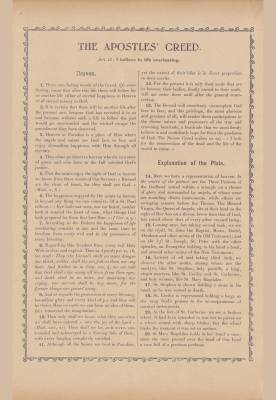
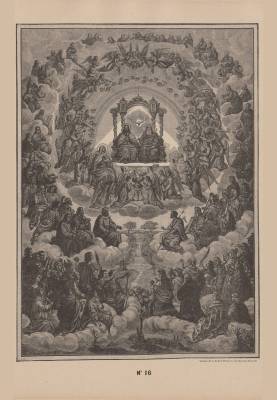
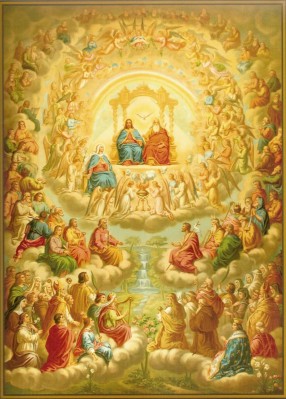
THE APOSTLES’ CREED.
Art 12: I believe in the life everlasting.
Heaven.
1. These concluding words of the Creed, life everlasting, mean that after this life there will follow for us another life either of eternal happiness in heaven or of eternal misery in Hell.
2. It is certain that there will be another life after the present one, because God has revealed it to us, and because without such a life to follow the just would go unrewarded and the wicked escape the punishment they have deserved.
3. Heaven or paradise is a place of bliss where the angels and saints see God face to face and enjoy abounding happiness with Him through all eternity.
4. They alone go direct to heaven who die in a state of grace and who have to the full satisfied God’s justice.
5. That the saints enjoy the sight of God in heaven we know from these words of Our Saviour: « Blessed are the clean of heart, for they shall see God. » (Matt. V, 8.)
6. The happiness enjoyed by the saints in heaven is beyond any thing we can conceive. Of it St. Paul tells us: « Eye hath not seen, nor ear heard, neither hath it entered the heart of man, what things God hath prepared for them that love Him. » (I Cor. II, 9.)
7. According to the Fathers the happiness of life everlasting life consists at one and the same time in freedom from every evil and in the possession of every blessing.
8. Regarding this freedom from every evil Holy Writ is clear and explicit: Thus in Apocalypse VI, 16, we read: They (the blessed) shall no more hunger nor thirst, neither shall the sun fall on them nor any heat. And further on in chap. XXI, 4, we are told that God shall wipe away all
tears from their eyes, and death shall be no more, nor mourning, nor crying, nor sorrow shall be any more, for the former things are passed away.
9. And as regards the possession of every blessing, boundless glory and every kind of joy and bliss will be theirs. Here on earth we can form no idea of them; they transcend the imagination.
10. Then only shall we know what they are when we shall have entered « into the joy of the Lord » (Matt. XXV, 21). Then shall we be, as it were, surrounded and submerged in a flowing tide of them, with every longing completely satisfied.
11. Although all the Saints see God in paradise, yet the extent of their bliss is in direct proportion to their merits.
12. For the present it is only their souls that are in heaven; their bodies, finally united to their souls, will not enter there until after the general resurrection.
13. The blessed will ceaselessly contemplate God face to face, and this privilege, the most glorious and precious of all, will render them participators in the divine nature and processors of the true and crowing beatitude, a beatitude that we must firmly believe in and confidently hope for from the goodness of God. The Nicene Creed makes us say: « I look for the resurrection of the dead and the life of the world to come. »
Explanation of the Plate.
14. Here we have a representation of heaven. In the center of the picture are the Three Persons of the Godhead seated within a triangle on a throne of glory and surrounded by angels, of whom some are sounding divers instruments, while others are swinging censers before the Throne. The Blessed Virgin, the Queen of Angels, sits at their head on the right of her Son on a throne lower than that of God, but raised above that of every other created being.
15. Coming next, but taking second rank, we see on the right, St. John the Baptist, Moses, David, Abraham and other saints of the Old Testament; and on the left St. Joseph, St. Peter with the other apostles,
an Evangelist holding in his hand a book, and several other saints of the New Testament.
16. Lowest of all and taking third rank, we observe the other saints, among whom are the martyrs, like St. Stephen, holy pontiffs, a king, virgin martyrs, like St. Cecilia and St. Catherine, and holy women, like St. Mary Magdalen.
17. St. Stephen is shown holding a stone in his hand, as he was stoned to death.
18. St. Cecilia is represented holding a harp, as she sang God’s praises to the accompaniment of musical instruments.
19. At the feet of St. Catherine we see a broken wheel. It had been intended to tear her to pieces on a wheel armed with shard blades; but the wheel broke the moment set in motion.
20. St Mary Magdalen in her hand a vase, since she once poured over the head of Our Lord a vase full of a precious perfume.
Catechism in Pictures – Text & picture 17
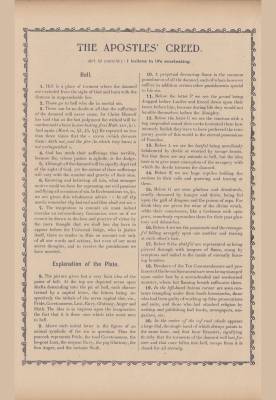
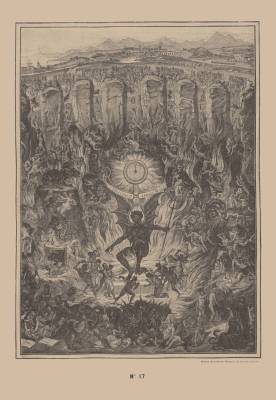
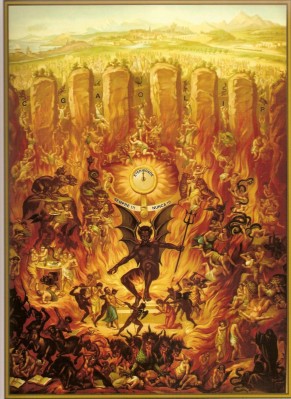
THE APOSTLES’ CREED
Art 12 (concld.): I believe in the life everlasting.
Hell.
1. Hell is a place of torment where the damned are excluded from the sight of God and burn with the demons in unquenchable fire.
2. Those go to hell who die in mortal sin.
3. There can be no doubt at all that the sufferings of the damned will never cease, for Christ Himself has said that at the last judgment, the wicked will be condemned to burn in everlasting fire. (Matt. XXV, 41). And again (Mark IX, 43, 45, 47) He repeated no less than three times that the « worm (which devours them) dieth not, and the fire (in which they burn) is not extinguished ».
4. God has made their sufferings thus terrible, because He, whose justice is infinite, is the Judge.
5. Although all the damned will be equally deprived of the sight of God, yet the extent of their sufferings will vary with the number and gravity of their sins.
6. Knowing and believing all this, what stronger motive could we have for repressing our evil passions and flying all occasions of sin. In Ecclesiasticus VII, 40, we are given this wholesome advice: « In all thy works remember thy last end and thou shall not sin. »
7. The temptation to commit sin must indeed exercise an extraordinary fascination over us if we cannot be drawn to the love and practice of virtue by the mere thought that we shall one day have to appear before the Universal Judge, who is justice itself, there to render to Him an account not only of all our words and actions, but even of our most secret thoughts, and receive the punishment we have merited.
Explanation of the Plate.
8. The picture gives but a very faint idea of the pains of hell. At the top are depicted seven open shafts descending into the pit of hell, each characterised by a capital letter, the letters being the initials of the seven capital sins, viz., Pride, Covetousness, Lust, Envy, Gluttony, Anger, and Sloth. The idea is to impress upon the imagination the fact that it is these sins which take most men to hell.
9. Above each initial letter is the figure of an animal symbolic of the sin in question. Thus the peacock represents Pride, the toad Covetousness, the he-goat Lust, the serpent Envy, the pig Gluttony, the lion Anger, and the tortoise Sloth.
10. A perpetual devouring flame is the common punishment of all the damned; each of whom however suffers in addition certain other punishments special to his sin.
11. Below the letter P we see the proud being dragged before Lucifer and forced down upon their knees before him, because during life they would not humble themselves before the Almighty.
12. Below the letter C we see the covetous with a bag suspended round their necks to remind them how intensely foolish they were to have to have preferred the temporary goods of this world to the eternal possessions of Paradise.
13. Below L we see the lustful being mercilessly belaboured by devils or worried by savage beasts. Not that there any animals in hell, but the idea here is to give some conception of the savagery with which the devils torment the damned.
14. Below E we see huge reptiles holding the envious in their coils and gnawing and tearing at them.
15. Below G are seen gluttons and drunkards, cruelly devoured by hunger and thirst, being fed upon the gall of dragons and the poison of asps. For drink they are given the wine of divine wrath, while their consciences ceaselessly reproaches them for their past gluttony and debauches.
16. Below A we see the passionate and the revengeful falling savagely upon one another and tearing at each other’s hair.
17. Below S the slothful are represented as being pierced through with tongues of flame, stung by scorpions and nailed to the inside of eternally burning braziers.
18. Breakers of the Ten Commandments and profaners of the Seven Sacraments are seen being stamped upon under foot by a seven-headed and ten-horned monster, whose hot flaming breath suffocates them.
19. In the left-hand bottom corner are seen centaurs trampling under their hoofs heresiarchs, those who had been guilty of working up false prosecutions and suits, and those who had attacked religion writing and publishing bad books, newspapers, magazines, etc.
20. In the center of the infernal abode appears a large dial, the single hand of which always points to the same hour, and that hour ETERNITY, signifying thereby that the torments of the damned will last for ever and that once fallen into hell, escape from it is closed for all eternity.
Catechism in Pictures – Text & picture 18
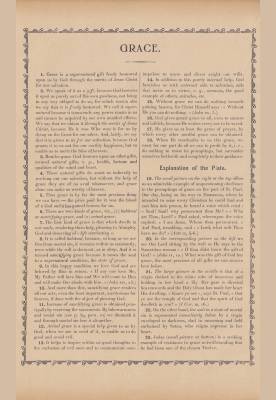
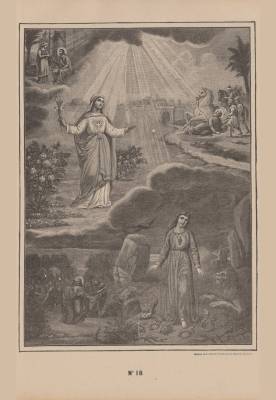
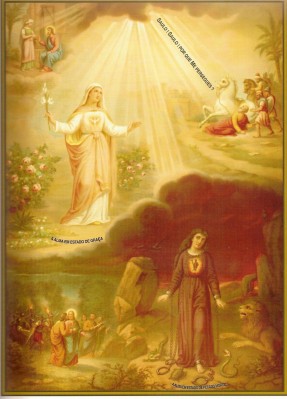
Grace.
1. Grace is a supernatural gift freely bestowed upon us by God through the merits of Jesus Christ for our salvation.
2. We speak of it as a free gift, because God bestows it upon us purely out of His own goodness, not being in any way obliged to do so, for which reason also we say that it is freely bestowed. We call it supernatural because it transcends any powers innate in us and cannot be acquired by our own unaided efforts. We say that we obtain it through the merits of Jesus Christ, because He it was Who won it for us by dying on the Cross for our sakes. And, lastly, we say that it is given to us for our salvation, because God grants it to us, not for our earthly happiness, but to enable us to merit the bliss of heaven.
3. Besides grace God bestows upon us other gifts, termed natural gifts, e. g., health, fortune and qualities of the mind and heart.
4. These natural gifts do assist us indirectly in working out our salvation, but without the help of grace they are of no avail whatsoever, and grace alone can make us worthy of heaven.
5. Thus grace is by far the most precious thing we can have – the price paid for it was the blood of a God and it has gained heaven for us.
6. There are two kinds of grace, viz., (1) habitual or sanctifying grace, and (2) actual grace.
7. The first kind of grace is that which dwells in our souls, rendering them holy, pleasing to Almighty God and deserving of « life everlasting».
8. It is called habitual, because, so long as we are free from mortal sin, it remains within us constantly, even while the will is dormant, as in sleep. And it is termed sanctifying grace because it raises the soul to a supernatural condition, the state of grace.
9. In this happy condition we love God and are beloved by Him in return. « If any one loves Me, My Father will love him and We will come to him and will make Our abode with him. » (John XIV, 23.)
10. And more than this, sanctifying grace renders all our acts, even the least important, meritorious for heaven, if done with the object of pleasing God.
11. Increase of sanctifying grace is obtained principally by receiving the sacraments. By lukewarmness and venial sin (see p. 59, para. 10) we diminish it and through mortal sin lose it altogether.
12. Actual grace is a special help given to us by God, when we are in need of it, to enable us to do good and avoid evil.
13. It helps to within us good thoughts to the exclusion of evil one exclude evil ones and to communicate sane impulses to move and direct aright our wills.
14. In addition to this purely internal help, God furnishes us with external aids to salvation, aids that incite us to virtue, e.g. sermons, the good example of others, miracles, etc.
15. Without grace we can do nothing towards gaining heaven, for Christ Himself says: « Without Me You can do nothing. » (John XV, 5.)
16. God gives actual grace to all, even to sinners and infidels, because He wishes every one to be saved.
17. He gives us at least the grace of prayer, by which every other needful grace can be obtained.
18. When He vouchsafes to us this grace, we must for our part do all we can to profit by it, i. e., do nothing to resist its promptings, but surrender ourselves forthwith and completely to their guidance.
Explanation of the Plate.
19. The small picture on the right at the top offers us an admirable example of unquestioning obedience to the promptings of grace on the part of St. Paul. One day, being on his way to Damascus, where he intended to seize every Christian he could find and cast him into prison, he heard a voice which cried: « Saul! Saul! why persecutest thou Me? » « Who art Thou, Lord? » Paul asked, whereupon the voice replied: « I am Jesus, Whom thou persecutest. » And Paul, trembling, said: « Lord, what wilt Thou have me do? » (Acts IX, 4-6.)
20. In the corresponding picture on the left we see Our Lord sitting by the well saying to the Samaritan woman: ‘If thou didst know the gift of God!’ (John IV, 10). This gift of God is grace, the most precious of all gifts we can receive here below.
21. The large picture in the middle is that of a virgin clothed in the white robe of innocence and holding in her hand a lily. Her gaze is directed heavenwards and the Holy Ghost has made her heat dwelling. « Know ye not », says St. Paul, « that ye are the temple of God and that the spirit of God dwelleth in you? » (I Cor. III, 16)
22. On the other hand, the soul in a state of mortal sin is represented immediately below by a virgin enveloped in darkness, clad in mourning and held enchained by Satan, who reigns supreme in her heart.
23. Judas (small picture at the bottom) is a striking example of resistance to grace, notwithstanding that he had been one of the chosen Twelve.
Catechism in Pictures – Text & picture 19
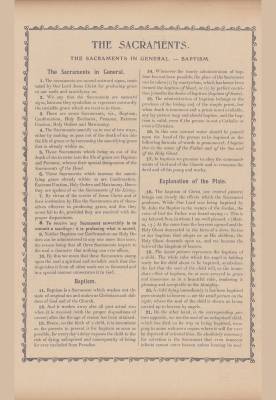
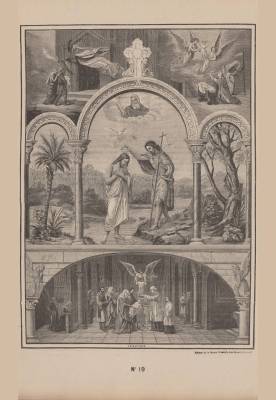
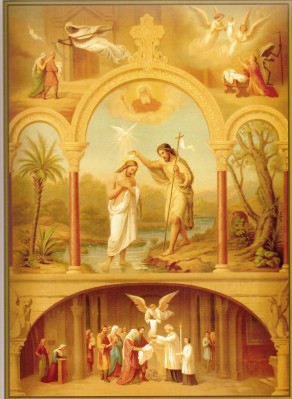
THE SACRAMENTS.
THE SACRAMENTS IN GENERAL. – BAPTISM
The Sacrament in General.
1. The sacraments are sacred outward sings, instituted by Our Lord Jesus Christ for producing grace in our sanctifying us.
2. We say that the Sacraments are outward signs, because they symbolise or represent outwardly the invisible grace which we receive in them.
3. There are seven Sacraments, viz., Baptism, Confirmation, Holy Eucharist, Penance, Extreme Unction, Holy Orders and Matrimony.
4. The Sacraments sanctify us in one of two ways, either by making us pass out of the death of sin into the life of grace or by increasing the sanctifying grace that is already within us.
5. Those Sacraments which bring us out of the death of sin to enter into the life of grace are Baptism and Penance, whence their special designation of the Sacraments of the Dead.
6. Those Sacraments which increase the sanctifying grace already within us are Confirmation, Extreme Unction, Holy Orders and Matrimony. Hence they are spoken of as the Sacraments of the Living.
7. By virtue of the merits of Jesus Christ and of their institution by Him the Sacraments are of themselves effective in producing grace, and this they never fail to do, provided they are received with the proper dispositions.
8. To receive any Sacrament unworthily is to commit a sacrilege: it is profaning what is sacred.
9. Neither Baptism nor Confirmation nor Holy Orders can be administered to any one more than once, the reason being that all three Sacraments impart to the soul a character that nothing can ever efface.
10. By this we mean that these Sacraments stamp upon the soul a spiritual and invisible mark that distinguishes it from all other souls not so favoured and in a special manner consecrates it to God.
Baptism.
11. Baptism is a Sacrament which washes out the stain of original sin and makes us Christians and children of God and of the Church.
12. And it washes away also all past actual sins when it is received (with the proper dispositions of course) after the age of reason has been attained.
13. Hence, on the birth of a child, it is incumbent on the parents to present it for baptism as soon as possible, for every day’s delay exposes the child to the risk of dying unbaptised and consequently of being for ever excluded from Paradise.
14. Whenever the timely administration of baptism has not been possible, the place of the Sacrament can be taken (1) by martyrdom, which has hence been termed the baptism of blood, or (2) by perfect contrition joined to the desire of baptism (baptism of desire).
15. The administration of baptism belongs to the province of the bishop and of the simple priest, but when death is imminent and a priest is not available, any lay person may and should baptise, and the baptism is valid, even if the person is not a Catholic or even a Christian.
16. In this case natural water should be poured upon the head of the person to be baptised as the following formula of words is pronounced: I baptise thee in the name of Father and the Son and of the Holy Ghost.
17. In baptism we promise to obey the commandments of God and of the Church and to renounce the devil and all his pomp and works.
Explanation of the Plate.
18. The baptism of Christ (see central picture) brings out clearly the effects which the Sacrament produces. While Our Lord was being
baptised by St. John the Baptist in the waters of the Jordan, the voice of God the Father was heard saying: « This is my beloved Son, in whom I am well pleased. » (Matt. III, 17.) At the same time the heavens opened and the Holy Ghost descended in the form of a dove. So too at our baptism God adopts us as His children, the Holy Ghost descends upon us, and we become the heirs of the kingdom of heaven.
19. The lower picture represents the baptism of a child. The white robe which the angel is holding ready for the child about to be baptised, symbolises the fact that the soul of the child will, as the immediate effect of baptism, be at once arrayed in grace and innocence as in a beautiful robe, rendering it pleasing and acceptable to the Almighty.
20. A child dying immediately it has been baptised goes straight to heaven – see the small picture on the right, where the soul of the child is shown as being carried up to heaven by angels.
21. On the other hand, in the corresponding picture opposite, we see the soul of an unbaptised child, which has died on its way to being baptised, escaping to some unknown region where it will for ever be deprived of celestial bliss. So absolutely necessary for salvation is the Sacrament that even innocent infants cannot enter heaven unless bearing its seal.
Catechism in Pictures – Text & picture 20
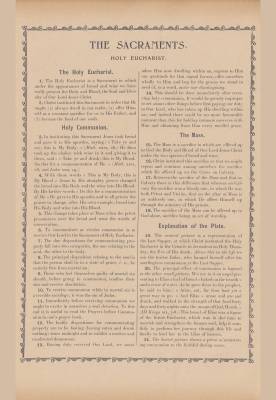
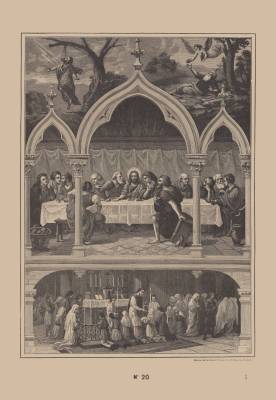
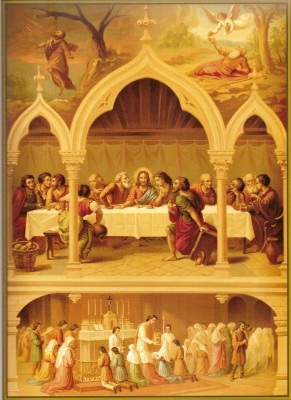
THE SACRAMENTS.
HOLY EUCHARIST.
The Holy Eucharist.
1. The Holy Eucharist is a Sacrament in which under the appearances of bread and wine we have really present the Body and Blood, the Soul and Divinity of Our Lord Jesus Christ.
2. Christ instituted this Sacrament, in order that He might (1) always dwell in our midst, (2) offer Himself as a constant sacrifice for us to His Father and (3) become the food of our souls.
Holy Communion.
3. In instituting this Sacrament Jesus took bread and gave it to His apostles, saying: « Take ye and eat; this is My Body. » (Matt. XXVI, 26.) He then took up the chalice with wine in it and giving it to them, said: « Take ye and drink; this is My Blood. Do this for a commemoration of Me. » (Matt. XXVI, 28, and Luke XXII, 19.)
4. With these words « This is My Body, this is My Blood » Jesus by His Almighty power changed the bread into His Body and the wine into His Blood. By His farther words « Do this for a commemoration of me » He gave to His apostles and to all priests the power to change, after His own example, bread into His Body and wine into His Blood.
5. This change takes place at Mass when the priest pronounces over the bread and wine the words of consecration.
6. To communicate or receive communion is to receive our Lord in the Sacrament of Holy Eucharist.
7. The due dispositions for communicating properly fall into two categories, the one relating to the soul, the other to the body.
8. The principal disposition relating to the soul is that the person shall be in a state of grace, i. e., be entirely free from mortal sin.
9. Those who feel themselves guilty of mortal sin should, before going to communion, confess their sins and receive absolution.
10. To receive communion while in mortal sin is a terrible sacrilege; it was the sin of Judas.
11. Immediately before receiving communion we ought to excite in ourselves a real devotion. To this end it is useful to read the Prayers before Communion in one’s prayer book.
12. The bodily dispositions for communicating properly are to fasting (having eaten and drunk nothing) since midnight and to exhibit a modest and recollected demeanour.
13. Having duly received Our Lord, we must adore Him now dwelling within us, express to Him our gratitude for that signal favour, offer ourselves wholly to Him and beg for the graces we stand in need of, in a word, make our thanksgiving.
14. This should be done immediately after receiving holy communion. It would be grossly improper to set about other things before first paying our duty to Our Lord, who has taken up His dwelling within us; and indeed there could be no more favourable moment than this for holding intimate converse with Him and obtaining from Him every needful grace.
The Mass.
15. The Mass is a sacrifice in which are offered to God the Body and Blood of Our Lord Jesus Christ under the two species of bread and wine.
16. Christ instituted this sacrifice so that we might repeat and continue among ourselves the sacrifice which He offered up on the Cross on Calvary.
17. Between the sacrifice of the Mass and that on Calvary there is this difference that whereas on Calvary the sacrifice was a bloody one, in which He was both Priest and Victim, that on the altar at Mass is an
unbloody one, in which He offers Himself up through the ministry of His priests.
18. The sacrifice of the Mass can be offered up to God alone, sacrifice being an act of worship.
Explanation of the Plate.
19. The central picture is a representation of the last supper, at which Christ instituted the Holy Eucharist in the cenacle in Jerusalem on Holy Thursday, the Eve of His death. Above this on the left we see the traitor Judas, who hanged himself after his sacrilegious communion at the Last Supper.
20. The principal effect of communion is figured in the other small picture. We see in it an angel presenting to Elias a loaf of bread « baked on the hearth » and a cruse of water. As he gave these to the prophet, he said to him: « Arise, eat, for thou hast yet a great way to go. » And Elias « arose and ate and drank, and walked in the strength of that food forty days and forty nights unto the mount of God, Horeb. » (II Kings XIX, 7-8.) This bread of Elias was a figure of the future Eucharist, which was in due time to nourish and strengthen the human soul, help it worthily to perform her journey through this life and finally to lead her to the bliss of heaven.
21. The lowest picture shows a priest administering communion to the faithful during mass.
Catechism in Pictures – Text & picture 21
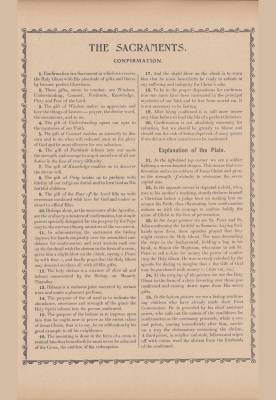
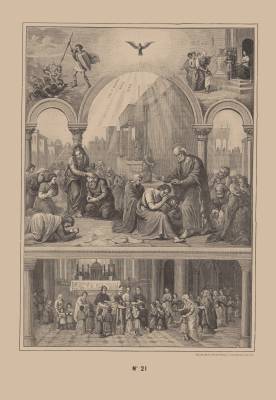
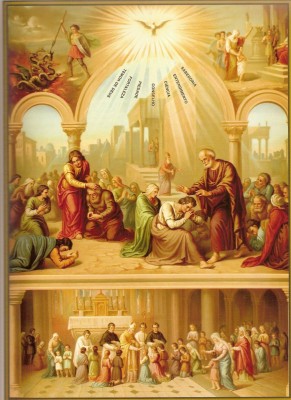
THE SACRAMENTS.
CONFIRMATION.
1. Confirmation is a Sacrament in which we receive the Holy Ghost with His plenitude of gifts and thereby become perfect Christians.
2. These gifts, seven in number, are Wisdom, Understanding, Counsel, Fortitude, Knowledge, Piety and Fear of the Lord.
3. The gift of Wisdom makes us appreciate and love the things of heaven – prayer, the divine word, the sacraments, and so on.
4. The gift of Understanding opens our eyes to the mysteries of our Faith.
5. The gift of Counsel enables us correctly to discern and to do what will redound most to the glory of God and be most effective for our salvation.
6. The gift of Fortitude infuses into our souls the strength and courage to acquit ourselves of all our duties in the face of every difficulty.
7. The gift of knowledge enables us to discover the divine will.
8. The gift of Piety incites us to perform with fidelity all our religious duties and to love God as His faithful children.
9. The gift of the Fear of the Lord fills us with reverence combined with love for God and makes us dread to offend Him.
10. Bishops alone, as the successors of the Apostles, are the ordinary ministers of confirmation, but simple priests specially delegated for the purpose by the Pope may be the extraordinary ministers of the sacrament.
11. In administering the sacrament the bishop imposes his hands conjointly over the assembled candidates for confirmation and next anoints each one on the forehead with the chrism in the form of a cross, gives him a slight blow on the cheek, saying « Peace be with thee », and finally prays that the Holy Ghost may descend on them all with all His gifts.
12. The holy chrism is a mixture of olive oil and balsam consecrated by the bishop on Maundy Thursday.
13. Balsam is a resinous excreted by certain trees and emits a pleasant perfume.
14. The purpose of the oil used is to indicate the abundance, sweetness and strength of the grace the Holy Spirit infuses into the person confirmed.
15. The purpose of the balsam is to impress upon him that he ought now to prove as the sweet odour of Jesus Christ, that is to say, be an edification by his good example to all his neighbours.
16. The anointing is done in the form of a cross to remind him that henceforth he must never be ashamed of the Cross, the emblem of his redemption.
17. And the slight blow on the cheek is to warn him that he must henceforth be ready to submit to any suffering and indignity for Christ’s sake.
18. To be in the proper dispositions for confirmation one must have been instructed in the principal mysteries of our faith and be free from mortal sin. It is not necessary to be fasting.
19. After being confirmed, it is still more necessary than before to lead the life of a perfect Christian.
20. Confirmation is not absolutely necessary for salvation, but we should be greatly to blame and should run the risk of being deprived of many graces if we did not allow ourselves to be confirmed.
Explanation of the Plate.
21. In the left-hand top corner we see a soldier fighting a seven-headed-dragon. This means that signifies that confirmation makes us soldiers of Jesus Christ and gives us the strength (fortitude) to overcome the seven capital sins.
22. In the opposite corner is depicted a child, who, true to his mother’s teaching, stoutly declares himself a Christian before a judge bent on making him renounce his Faith, thus illustrating how confirmation
imbues us with the courage to confess boldly the name of Christ in the face of persecution.
23. In the large picture we see St. Peter and St. John confirming the faithful in Samaria. Laying their hands upon them, these apostles prayed that they might receive the Holy Ghost. The man descending the steps in the background, holding a bag in his hand, is Simon the Magician, who came to ask St. Peter to sell to him for money the power of conferring the Holy Ghost. He was severely rebuked by the apostle for daring to imagine that « the Gift of God may be purchased with money ». (Acts VIII, 20.)
24. At the very top of the picture we see the Holy Ghost in the form of a dove hovering over those just confirmed and raising down upon them His seven gifts.
25. In the bottom picture we see a bishop confirming children who have already made their First Communion. He is preceded by his chief assistant priest, coming immediately after him, carries on a tray the chrismatory containing the chrism. A third priest, in surplice and stole, follows and wipes off with cotton wool the chrism from the foreheads of the confirmed.
Catechism in Pictures – Text & picture 22
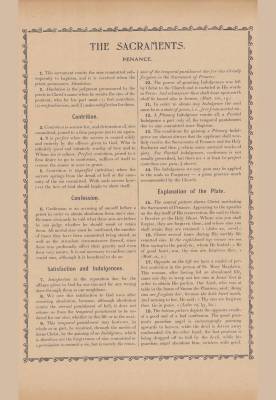

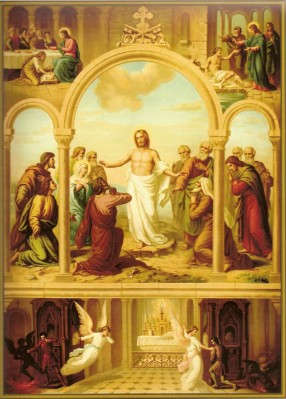
THE SACRAMENTS.
PENANCE.
1. This sacrament remits the sins committed subsequently to baptism, and it is received when the priest pronounces Absolution.
2. Absolution is the judgment pronounced by the priest in Christ’s name when he remits the sins of the penitent, who for his part must (1) feel contrition, (2) confess his sins, and (3) make satisfaction for them.
Contrition.
3. Contrition is sorrow for, and detestation of, sins committed, joined to a firm purpose not to sin again.
4. It is perfect when the sorrow is caused solely and entirely by the offence given to God, Who is infinitely good and infinitely worthy of love and to Whom sin is odious. Perfect contrition, joined to a firm desire to go to confession, suffices of itself to restore the sinner at once to grace.
5. Contrition is imperfect (attrition) when the sorrow springs from the dread of hell or the enormity of the sin committed. With such sorrow however the love of God should begin to show itself.
Confession.
6. Confession is an accusing of oneself before a priest in order to obtain absolution from one’s sins. He must obviously be told what these sins are before he can judge whether he should remit or retain them. All mortal sins must be confessed, the number of times they have been committed being stated, as well as the attendant circumstances thereof, since these may profoundly affect their gravity and even their very nature. It is not necessary to confess one’s venial sins, although it is beneficial to do so.
Satisfaction and indulgences.
7. Satisfaction is the reparation due for the offence given to God by our sins and for any wrong done through them to our neighbour.
8. We owe this satisfaction to God even after receiving absolution, because, although absolution remits the eternal punishment of hell, it does not release us from the temporal punishment to be endured for our sins, whether in this life or in the next.
9. This temporal punishment may however, in whole or in part, be remitted, through the merits of Jesus Christ, by the gaining of an Indulgence, which is therefore not the forgiveness of sins committed or a permission to commit a sin, but is merely the remission of the temporal punishment due for sins already forgiven in the Sacrament of Penance.
10. The power of granting Indulgences was left by Christ to the Church and is included in His words to Peter: And whatsoever thou shalt loose upon earth shall be loosed also in heaven. (Matt. XVI, 19.)
11. In order to obtain any Indulgence the soul must be in a state of grace, i.e., free from mortal sin.
12. A Plenary Indulgence remits all, a Partial Indulgence a part only of, the temporal punishment due to sins committed since Baptism.
13. The conditions for gaining a Plenary indulgence are almost always that the applicant shall worthily receive the Sacraments of Penance and the Holy Eucharist and then perform some outward works of piety. For Partial Indulgences confession is not usually prescribed, but there must at least be perfect contrition (see para, 4 above).
14. The Indulgences we may gain be applied to the souls in Purgatory – a pious practice much recommended by the Church.
Explanation of the Plate.
15. The central picture shows Christ instituting the Sacrament of Penance. Appearing to the apostles on the day itself of His resurrection, He said to them: « Receive ye the Holy Ghost. Whose sins you shall forgive, they are forgiven them, and whose sins you shall retain they are retained. » (John XX, 22-23.)
16. Christ several times during His earthly life remitted sins. In the right-hand top corner, we see Him saying to the paralytic, whom He healed: « Be of good heart, son, thy sins are forgiven thee. » (Matt. IX, 2.)
17. Opposite on the left we have a model of perfect contrition in the person of St. Mary Magdalen. This woman, after having led an abandoned life, came one day to weep out her sins at Jesus’ feet in order to obtain His pardon. Our Lord, was at table in the house of Simon the Pharisee, said: Many sins are forgiven her, because she hath loved much. And turning to her, He said: « Thy sins are forgiven thee. Go in peace. » (Luke VII, 47, 50.)
18. The bottom picture depicts the opposite results of a good and of a bad confession. The good penitent’s guardian angel is encouragingly pointing upwards to heaven, while the devil is driven away confounded. On the other hand, the bad penitent is being dragged off to hell by the devil, while his guardian angel abandons him, stricken with grief.
Catechism in Pictures – Text & picture 23
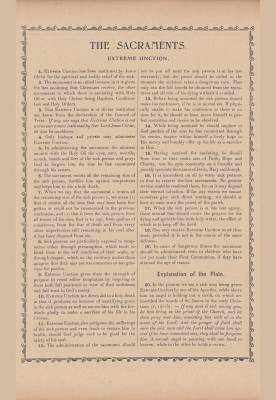
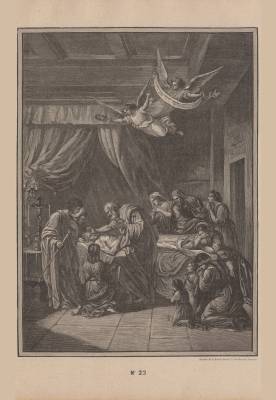
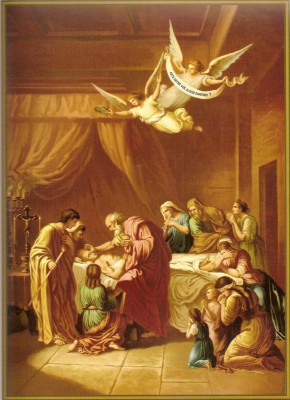
THE SACRAMENTS.
EXTREME UNCTION.
1. Extreme Unction has been instituted by Jesus Christ for the spiritual and bodily relief of the sick.
2. The sacrament is so called because in it is given the last anointing that Christians receive, the other sacraments in which there is anointing with Holy Oil or with Holy Chrism being Baptism, Confirmation and Holy Orders.
3. That Extreme Unction is of divine institution we know from the declaration of the Council of Trent: If any one says that Extreme Unction is not a true sacrament instituted by Our Lord Jesus Christ, let him be anathema.
4. Only bishops and priests may administer Extreme Unction.
5. In administering the sacrament the minister anoints with the Holy Oil the eyes, ears, nostrils, mouth, hands and feet of the sick person and prays God to forgive him the sins he has committed through his senses.
6. The sacrament remits all the remaining sins of the sick person, fortifies him them against temptations and helps him to die a holy death.
7. When we say that the sacrament « remits all the remaining sins of the sick person », we mean (1) that it remits all the sins that may have been forgotten or could not be enumerated in the previous confession, and (2) that it frees the sick person from all traces of his sins, that is to say, from qualms of conscience, from the fear of death and from every other imperfection still remaining in his soul after it has been cleansed from sin.
8. Sick persons are particularly exposed to temptation either through presumption, which tends to blind them to the evil condition of their souls, or through despair, which on the contrary makes them imagine that their sins are too numerous or too grievous for pardon.
9. Extreme Unction gives them the strength of purpose to resist either temptations by inspiring in them both full penitence in view of for their sinfulness and full trust in God’s mercy.
10. Extreme Unction is a direct aid to a holy death in that it produces an increase of sanctifying grace in the sick person as well as nerves him with the fortitude gladly to make a sacrifice of his life to his Creator.
11. Extreme Unction also mitigates the sufferings of the sick person and even tends to restore him to health, should God judge such to be good for the safety of his soul.
12. The administration of the sacrament should not be put off until the sick person is at his last extremity, but the priest should be called in the moment the sickness takes a dangerous turn. Thus only can the full benefit be obtained from the sacrament and all risk of his dying without it avoided.
13. Before being anointed the sick person should make his confession, if he is in mortal sin. If physically unable to make his confession or there is no time for it, he should at least move himself to perfect contrition and desire to be absolved.
14. While being anointed he should implore of God pardon of the sins he has committed through his senses, inspire within himself a lively hope in His mercy and humbly offer up his life as a sacrifice to Him.
15. Having received the anointing, he should from time to time make acts of Faith, Hope and Charity, rest his eyes constantly on a Crucifix and piously ejaculate the names of Jesus, Mary and Joseph.
16. It is incumbent on all to warn sick persons in time to receive the last sacraments. No greater service could be rendered them, for on it may depend their eternal salvation. If for any reason we cannot ourselves give such direct warning, we should at least at once warn the priest of the parish.
17. When the sick person is at his last agony, those around him should recite the prayers for the dying and sprinkle him with holy water, the effect of which is to keep off the devil away.
18. One may receive Extreme Unction more than once, provided it is not in the course of the same sickness.
19. In cases of dangerous illness the sacrament should be administered even to children who have not yet made their First Communion, if they have attained the age of reason.
Explanation of the Plate.
20. In the picture we see a sick man being given Extreme Unction by one of the Apostles, while above him an angel is holding out a scroll, on which are inscribed the words of St. James to the early Christians (V, 14-15): – If any man is sick among you, let them pray over him, anointing him with oil in the name of the Lord. And the prayer of faith shall save the sick man and the Lord shall raise him up; and if he have committed sins, they shall be forgiven him. A second angel is pointing with one hand to heaven, while in the other he holds a crown.
Catechism in Pictures – Text & picture 24
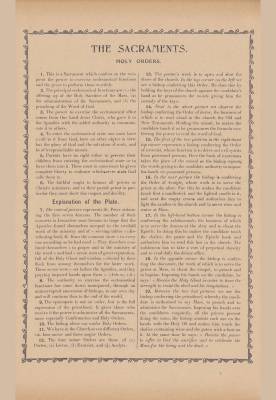
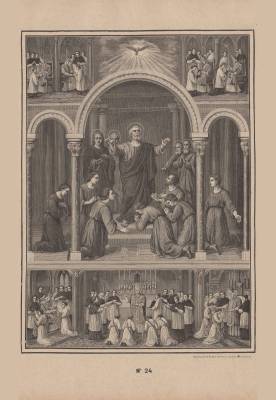
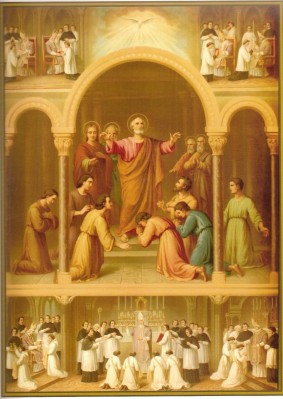
THE SACRAMENTS.
HOLY ORDERS.
1. This is a Sacrament which confers on the recipient the power to exercise ecclesiastical functions and the grace to perform them worthily.
2. The principal ecclesiastical functions are (1) the offering up of the Holy Sacrifice of the Mass, (2) the administration of the Sacraments, and (3) the preaching of the Word of God.
3. The power to exercise the ecclesiastical office comes from Our Lord Jesus Christ, who gave it to the Apostles with the added authority to communicate it to others.
4. To enter the ecclesiastical state one must have a call to it from God, have no other object in view but the glory of God and the salvation of souls, and be of irreproachable morals.
5. Parents have no right either to prevent their children from entering the ecclesiastical state or to force them into it. These must in conscience be given complete liberty to embrace whichsoever state God calls them to.
6. The faithful ought to honour all priests as Christ’s ministers, and to their parish priest in particular they must show due respect and docility.
Explanation of the Plate.
7. The central picture represents St. Peter ordaining the first seven deacons. The number of their converts in Jerusalem soon became so large that the Apostles found themselves unequal to the twofold work of the ministry and of « serving tables » (distributing food, &. from the common store « to every one according as he had need ». They therefore confined themselves « to prayer and to the ministry of the word » and had « seven men of great reputation, full of the Holy Ghost and wisdom » elected by their flock from among themselves for the latter work. These seven were « set before the Apostles, and they praying imposed hands upon them ». (Acts VI, 1-6.)
8. The authority to exercise the ecclesiastical functions has come down unimpaired, through an uninterrupted succession of bishops, to our own day and will continue thus to the end of the world.
9. The episcopate is not an order, but is the full expression of the priesthood. It gives those who receive it the power to administer all the Sacraments, more especially Confirmation and Holy Orders.
10. The bishop alone can confer Holy Orders.
11. We have in the Church seven different Orders, viz. four minor and three major Orders.
12. The four minor Orders are those of (1) Porter, (2) Lector, (3) Exorcist, and (4) Acolyte.
13. The porter’s work is to open and shut the doors of the church. In the top corner on the left we see a bishop conferring this Order. He does this by holding the keys of the church against the candidate’s hand as he pronounces the words giving him the custody of the keys.
14. Next to the above picture we observe the bishop conferring the Order of lector, the business of which is to read aloud in the church the Old and New Testaments. Holding the missal, he makes the candidate touch it as he pronounces the formula conferring the power to read the word of God.
15. The first of the two pictures in the top right-hand top corner represents a bishop conferring the Order of exorcist, whose function is to drive out evil spirits from possessed persons. Here the book of exorcisms takes the place of the missal as the bishop repeats the words giving to the candidate authority to impose his hands on possessed persons.
16. In the next picture the bishop is conferring the Order of Acolyte, whose work is to serve the priest at the altar. For this he makes the candidate touch first a candlestick and the lighted candle in it, and next the empty cruets and authorises him to light the candles in the church and to serve wine and water at Mass.
17. In the left-hand bottom corner the bishop is conferring the subdiaconate, the business of which is to serve the deacon at the altar and to chant the Epistle. In doing this he makes the candidate touch the chalice, the paten and the Epistle book and authorises him to read this
last in the church. The subdeacon has to take a vow of perpetual chastity and to read daily the divine office.
18. In the opposite corner the bishop is conferring the diaconate, the work of which is to serve the priest at Mass, to chant the Gospel, to preach and to baptize. Imposing his hands on the candidate, he says: « Receive the Holy Ghost in order to have the strength to resist the devil and his temptations. »
19. Between the two last pictures we see the bishop conferring the priesthood, whereby the candidate is authorised to say Mass, to preach and to administer the Sacraments. Imposing his hands over the candidates conjointly, all the priests present doing the same, the bishop anoints each one on the hands with the Holy Oil and makes him touch the chalice containing wine and the paten with a host on it. At the same time he says: « Receive the power to offer to God the sacrifice and to celebrate the Mass for the living and the dead. »
Catechism in Pictures – Text & picture 25

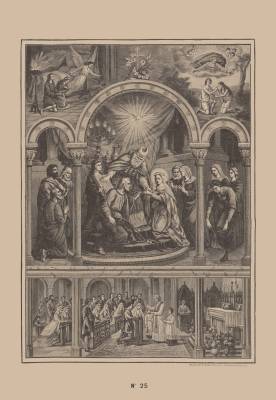
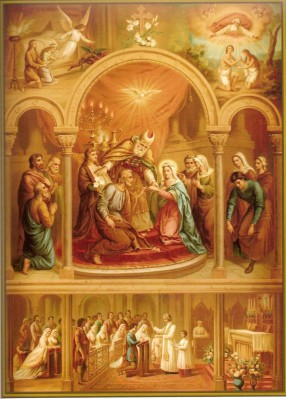
THE SACRAMENTS.
MATRIMONY.
1. This Sacrament sanctifies the contract of Christian marriage, giving to those who receive it worthily the special grace to love and be strictly faithful to each other, to assist each other in their daily needs, to bear up with each other’s shortcomings and to bring up their children in a Christian manner.
2. God Himself instituted marriage when He created our first parents, and Christ raised it to the dignity of a sacrament.
3. Marriage is indissoluble except by the death of one of the parties. « What God hath joined together, let no man put asunder. » (Matt. XIX, 6.)
4. There are two classes of impediments to marriage, viz., diriment and prohibitory, the one rendering it entirely null and void, the other without having a nullifying effect, making it sinful to contract it.
5. Of the eight diriment impediments, five are –
(a) consanguinity (See page 51, para. 8).
(b) Affinity (See page 51, para.8).
(c) Crime. – Persons committing murder or adultery with a view to being married together, render themselves incapable of such marriage.
(d) Difference of religion. – No marriage can take place between a baptised and an unbaptised person.
(e) Clandestinity. – Marriage must be contracted in a presence of the parish priest (or another duly authorised on this behalf by him or the bishop) and of at least two witnesses. Marriage before a Registrar or a Protestant minister is hence no Catholic marriage at all and those so united live in a constant state of mortal sin and remain debarred from the Sacraments and from burial by the Church.
6. Of the three prohibitory impediments, only that against mixed marriages need be dealt with here.
7. A mixed marriage is a marriage between a Catholic and one who, though baptised, is not a Catholic. Either domestic attachment or fear or ridicule sooner or later cools the fervour or weakens the faith of the Catholic party, while the children are easily persuaded to follow the less strict religion of the non-Catholic parent. When for some really grave reason such marriages are permitted by the Church, it must be mutually agreed upon (1) that the Catholic party shall in no way be interfered with in the exercise of his or her religion, (2) that all the children shall be brought up as Catholics, and (3) that the Catholic party shall endeavour to convert the other by every prudent means.
8. To make sure that no impediments to a proposed marriage exist, the Church requires the previous publication of banns.
9. Good cause being shown, dispensation from certain impediments may be obtained from the Pope or the bishop. The best way to steer clear of all irregularities is to consult one’s parish priest in good time before arranging to marry.
10. In order to receive worthily the Sacrament of Matrimony the parties should be inspired by Christian views and intentions, and should prepare themselves for it by prayer, by a good confession, and as much as possible by a good communion. To be married while in mortal sin is a sacrilege, which often brings down on the parties the curse of God.
11. The chief aim of marriage is the family, i. e., children born in wedlock and brought up in a Christian manner. The first marriage, that of Adam and Eve, was blessed by the Creator Himself in these words: « Increase and multiply. » St. Paul marks his high appreciation of legitimate motherhood by his declaration that woman « shall be saved through child-bearing if she continues in faith and love and sanctification with sobriety ». (I Tim. II, 15.)
Explanation of the Plate.
12. The central picture depicts the espousals of St. Joseph and the Blessed Virgin before the high priest in the temple at Jerusalem. The flowering lily St. Joseph holds reminds us of the beautiful tradition relating to his being chosen to become the spouse of Our Lady. The several aspirants for her hand, all belonging to the house of David, where called together by the high Priest and each given a blest leafless twig on which he was to inscribe his name. The twigs were then all placed on the altar and God besought to manifest His choice. When the twigs were examined later, it was found that St. Joseph’s alone had put forth leaves and a white flower like a lily. On the right we observe one of the rejected suitors, filled with despair, breaking his twig in two.
13. In the left-hand top corner we see the elder Tobias and Sara his wife preparing themselves for the married state by fervent prayer. While the angel Raphael is chasing away the devil who had killed the first seven husbands because of Sara because of their evilmindedness in regard to marriage. (Tob. III.)
14. The lowest picture shows a young Catholic man and woman being married before a priest.
15. In the top right-hand top corner we see Adam and Eve. God is blessing the pair with the words: « Increase and multiply. » (Gen. I, 28.)
Catechism in Pictures – Text & picture 26
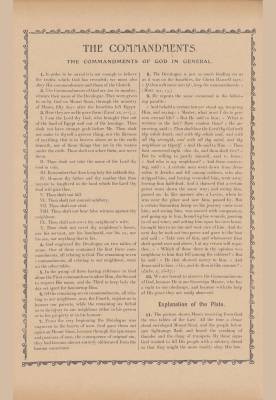
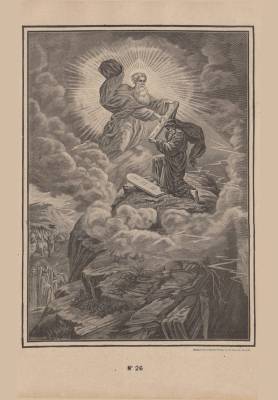

THE COMMANDMENTS.
THE COMMANDMENTS OF GOD IN GENERAL.
1. In order to be saved it is not enough to believe the truths that God has revealed; we must also obey His commandments and those of the Church.
2. The Commandments of God are ten in number, whence their name of the Decalogue. They were given to us by God on Mount Sinai, through the ministry of Moses, fifty days after the Israelites left Egypt.
3. Here they are as He gave them (Exod. XX, 2-17.):
I. I am the Lord thy God, who brought thee out of the land of Egypt and out of the bondage. Thou shalt not have strange gods before Me. Thou shalt not make to thyself a graven thing, nor the likeness of anything that is in heaven above or in the earth beneath, nor of those things that are in the waters under the earth, Thou shalt not adore them, nor serve them.
II. Thou shalt not take the name of the Lord thy God in vain.
III. Remember that thou keep holy the sabbath day.
IV. Honour thy father and thy mother that thou mayest be long-lived in the land which the Lord thy God will give thee.
V. Thou shalt not kill.
VI. Thou shalt not commit adultery.
VII. Thou shalt not steal.
VIII. Thou shalt not bear false witness against thy neighbour.
IX. Thou shalt not covet thy neighbour’s wife.
X. Thou shalt not covet thy neighbour’s house, nor his servant, nor his handmaid, nor his ox, nor his ass, nor anything that is his.
4. God engraved the Decalogue on two tables of stone. One of these contained the first three commandments, all relating to God. The
remaining seven commandments, all relating to our neighbour, were on the other table.
5. In the group of three having reference to God alone the First commands us to adore Him, the Second to respect His name, and the Third to keep holy the day set apart for honouring Him.
6. Of the remaining seven commandments, all relating to our neighbour, one, the Fourth, enjoins us to honour our parents, while the remaining six forbid us to do injury to our neighbour either in his person or in his property or in his honour.
7. From the very beginning the Decalogue was engraven in the hearts of men. God gave them out again on Mount Sinai, because through the ignorance and passions of men, the consequence of original sin, they had become almost entirely obliterated from the human conscience.
8. The Decalogue is just as much binding on us as it was on the Israelites, for Christ Himself says: « If thou wilt enter into life, keep the commandments. » (Matt. XIX, 17.)
9. He repeats the same command in the following parable:
« And behold a certain lawyer stood up, tempting Him, and saying: « Master, what must I do to possess eternal life? » But He said to him: « What is written in the law? How readest thou? » He answering, said: « Thou shalt love the Lord thy God with thy whole heart, and with thy whole soul, and with all thy strength, and with all thy mind, and thy neighbour as thyself. » And He said to Him: « Thou hast answered right: this do, and thou shalt live? » But he willing to justify himself, said to Jesus: « And who is my neighbour? » And Jesus answering, said: « A certain man went down from Jerusalem to Jericho, and fell among robbers, who also stripped him, and having wounded him, went away leaving him half-dead. And it chanced that a certain priest went down the same way; and seeing him, passed on. In like manner also a Levite, when he was near the place and saw him, passed by. But a certain Samaritan being on his journey came near him; and seeing him was moved with compassion, and going up to him, bound up his wounds, pouring in oil and wine; and setting him upon his own beast, brought him to an inn and took care of him. And the next day he took out two pence and gave to the host and said: « Take care of him; and whatsoever thou shalt spend over and above, I at my return will repay thee. » Which of these three in thy opinion was neighbour to him that fell among the robbers? » But he said:
« He that showed mercy to him. » And Jesus said to him: « Go, and do thou in like manner? » (Luke, X, 25-37.)
10. We are bound to observe the Commandments of God, because He is our Sovereign Master, who has a right to our obedience, and because with the help of His grace they are easily observed.
Explanation of the Plate.
11. The picture shows Moses receiving from God the two tables of the Law. All the time a dense cloud enveloped Mount Sinai, and the people below saw lightnings flash and heard the crashing of thunder and the clang of trumpets. By these signs God wished to fill His people with a salutary dread so that they might the more readily obey His law.
Catechism in Pictures – Text & picture 27
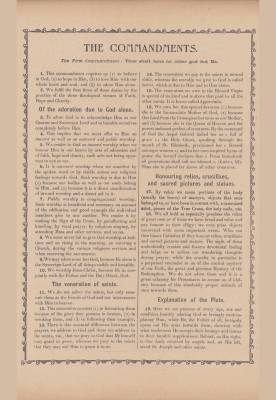
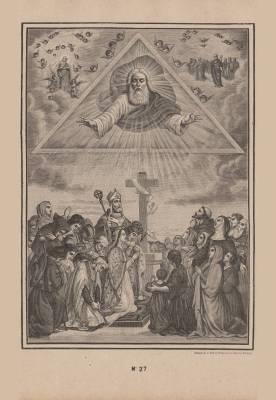

THE COMMANDMENTS.
The First Commandments: Thou shalt have no other god but Me.
1. This commandment requires us (1) to believe in God, (2) to hope in Him, (3) to love Him with our whole heart and soul, (4) to adore Him alone.
2. We fulfil the first three of these duties by the practice of the three theological virtues of Faith, Hope and Charity.
Of the adoration due to God alone.
3. To adore God is to acknowledge Him as our Creator and Sovereign Lord and to humble ourselves completely before Him.
4. This implies that we must offer to Him an inward as well as an outward and public worship.
5. We render to God an inward worship when we honour Him in our hearts by acts of adoration and of faith, home and charity, such acts not being apparent to eye or ear.
6. It is outward worship when we manifest by the spoken word or by visible action our religious feelings towards God. Such worship is due to Him (1) because our bodies as well as our souls belong to Him, and (2) because it is a direct manifestation of inward worship and a direct aid to it.
7. Public worship is congregational worship. Such worship is beneficial and necessary on account of the edification and good example the individual members give to one another. We render it by making the Sign of the Cross, by genuflecting and kneeling, by vocal prayer, by religious singing, by attending Mass and other services, and so on.
8. We must never fail to give God worship at bedtime and on rising in the morning, on entering a Church, during the various religious services and when receiving the sacraments.
9. We may adore none but God, because He alone is the Sovereign Lord of all things visible and invisible.
10. We worship Jesus Christ, because He is, conjointly with the Father and the Holy Ghost, God.
The veneration of saints.
11. We do not adore the saints, but only venerate them as the friends of God and our intercessors with Him in heaven.
12. This veneration consists (1) in honouring them because of the glory they possess in heaven, (2) in invoking them, (3) in following their example.
13. There is this essential difference between the prayers we address to God and those we address to the saints, viz., that we pray to God that He himself may grant us grace, whereas we pray to the saints that they may ask Him to grant it to us.
14. The veneration we pay to the saints is termed dulia, but the worship we give to God is called latria, which is due to Him and to Him alone.
15. The veneration we owe to the Blessed Virgin is special of its kind and is above that paid to all the other saints. It is hence called hyperdulia.
16. We owe her this special devotion (1) because she is the Immaculate Mother of God; (2) because Our Lord from the Cross gave her to us as our Mother, and (3) because she is the Queen of Heaven and the purest and the most perfect of creatures. By the command of God the Angel Gabriel hailed her as « full of grace »; the Holy Ghost, speaking through the mouth of St. Elizabeth, proclaimed her « blessed amongst women »; and in her own inspired hymn of praise, she herself declares that « From henceforth all generations shall call me blessed ». (Luke I, 48). Thus she is placed far above all other creatures.
Honouring relics, crucifixes, and sacred pictures and statues.
17. By relics we mean portions of the body (usually the bones) of martyrs, objects that once belonged to, or have been in contact with, a canonized saint, pieces of the True Cross, the holy nails, etc.
18. We all hold as especially precious the relics of great men or of those we have loved and pay honour to their effigy; we even prize objects connected with some important event. Who can then blame Catholics if they honour relics, crucifixes and sacred pictures and statues. The sight of them undoubtedly creates and fosters devotional feeling and helps us to collect our wandering thoughts during prayer, while the crucifix in particular is a perpetual reminder to us of the central mystery of our Faith, the great and glorious Mystery of the Redemption. We do not adore them and it is a gross calumny for Protestants to accuse us of idolatry because of this absolutely proper attitude of ours towards them.
Explanation of the Plate.
19. Here we see persons of every age, sex and condition humbly adoring God of lovingly contemplating Him, while He, the Father of all, benignly opens out His arms towards them, showing with what tenderness He accepts their homage and listens to their humble supplications. Behind, on His right, is Our Lady escorted by angels and, on His left, stand St. Joseph and other saints.
Catechism in Pictures – Text & picture 28

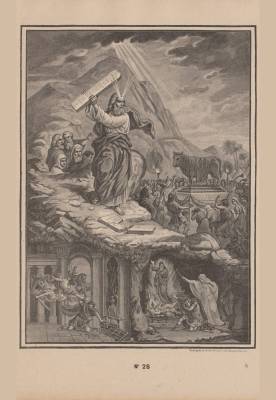
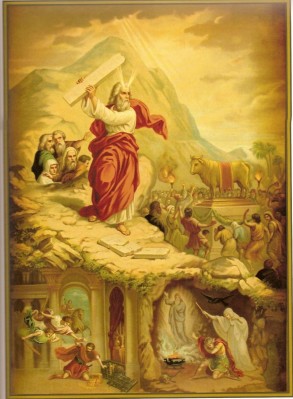
THE COMMANDMENTS.
The First Commandments (concl.):
Thou shalt have no other god but Me.
1. The First Commandment forbids (1) idolatry, (2) irreligion, and (3) superstition.
2. Idolatry is worship given to creatures.
3. Under irreligion are included (1) sacrilege, (2) turning religion and its ministers into ridicule, and (3) habitual neglect of one’s religious duties.
4. Sacrilege is profanation, with criminal intent, of what is sacred, and is a mortal sin. There are three kinds of sacrilege, viz. (1) sacrilege of the person, e.g., assaulting or killing a priest or nun; (2) sacrilege of the place, e.g,. creating a disturbance inside a church, desecrating a grave; and (3) sacrilege of the thing, e.g., making a bad confession or communion, stealing sacred vessels, damage in a church, handling relics disrespectfully, and so on.
5. Allied to sacrilege is simony, which is buying or selling sacred things and making a profit out of them because of their sacred character, e.g., selling a rosary for more than its cost price because it has been blessed. See page 21, para. 23 conclusion.
6. Under neglect of one’s spiritual duties we may include, besides actual neglect, also reading bad books, sending children to non-Catholic schools when Catholic ones are available, and taking part in prayers of a false religion.
7. We are guilty of superstition whenever we attribute to certain events, words or acts effects not assigned to them by God, such as the healing of sick persons by incantations, fortune-telling by cards, etc.
8. The principal superstitions are magic, witchcraft and belief in omens.
9. Magic is the art of doing things out of the ordinary course of nature with the help of the devil.
10. Witchcraft is the art of causing injury to men and animals through the power of the devil.
11. To presage from some ordinary fact or event that something good or evil is going to happen is to be guilty of beliefs in omens. Thus it is a superstition to believe that certain days are lucky or unlucky or that thirteen at table means that one of the thirteen will die in the course of the year.
12. We are guilty of superstition also if we believe in fortune-telling or in divination of any king.
13. Belief in the virtues of holy water or of any object blessed by the Church is not superstitious, because whatever beneficial effects we hope will follow from their use we expect from the almighty power of God and in virtue of the prayer said over them by the Church.
14. In the following extract from the Gospel we see Christ driving out the sellers and money changers trader from the temple because they were committing a sacrilege of the place:
« The Pasch of the Jews was at hand and Jesus went up to Jerusalem. And He found in the temple them that sold oxen and sheep and doves, and the changers of money sitting. And when He had made as it were a scourge of little cords, He drove them all out of the temple, the sheep also and the oxen, and the money of the changers He poured out and the tables He overthrew. And to them that sold doves He said: Take these things hence and make not the house of My Father a house of traffic. And His disciples remembered that it was written: « The zeal of thy house hath eaten me up! » (John II, 13-17)
Explanation of the Plate.
15. The principal picture represents the Israelites worshipping the golden calf in the desert. While Moses was absent holding converse with God on Mount Sinai, the Israelites, weary of waiting for him, asked Aaron, the High Priest, to make them a golden calf that they might worship it. Aaron did their bidding, and they prostrated themselves
before the idol and honoured it with prayers and dances. When Moses came down from the mountain bearing the Tables of the Law, he became so indignant at the sight of this idolatry, that he threw down the tables and broke them. (Exod. XXXII, 1-19.)
16. In the small picture on the left we see Heliodorus, a general of Seleucus, King of Syria, trying to seize the treasures collected in the temple at Jerusalem. As he was in the act of committing this sacrilegious robbery, he saw appear « a horse with a terrible rider upon him ». And the horse « ran fiercely and struck Heliodorus with his forefeet ». At the same time « there appeared two other young men, beautiful and strong, bright and glorious, and in comely apparel, who stood by him on either side and scourged him without ceasing with many stripes. And Heliodorus suddenly fell to the ground and they took him up covered with great darkness, and having put him into a litter they carried him out ». (II Mach. III.)
17. It was the sin of superstition that Saul committed when he went to consult the witch of Endor. In the small picture on the right we see him with the witch standing over him. At his request that she should summon the spirit of Samuel, who had been dead some time, Samuel, by God’s permission, appeared and informed him that he would be killed on the following day in battle with the Philistines. (I Kings, XXVIII.)
Catechism in Pictures – Text & picture 29
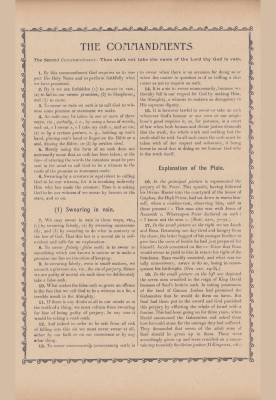
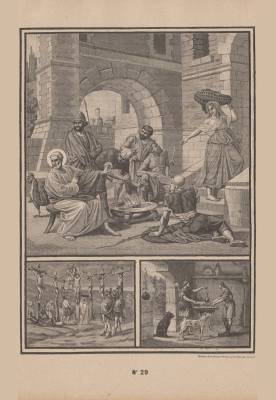
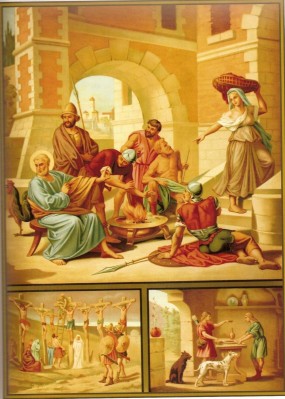
THE COMMANDMENTS.
The Second Commandment:
Thou shalt not take the name of the Lord thy God in vain.
1. By this commandment God requires us to respect His Holy Name and to perform faithfully what we have promised.
2. By it we are forbidden (1) to swear in vain, (2) to fail in our sworn promises, (3) to blaspheme, and (4) to curse.
3. To swear or take an oath is to call God to witness some promise or statement we make.
4. An oath may be taken in one or more of three ways, viz., (1) verbally, i.e., by using a form of words, such as, « I swear », «I take my oath », and so on; (2) or by a certain gesture, e. g., holding up one’s hand, placing one’s hand or finger on the Bible or a seal, kissing the Bible; (3) by written deed.
5. Merely using the form of an oath does not necessarily mean that an oath has been taken; at the time of uttering the words the intention must be present in the mind to call God to be a witness to the truth of the promise or statement made.
6. Swearing by a creature is equivalent to calling God to be our witness, for it is invoking indirectly Him who has made the creature. Thus it is asking God to be our witness if we swear by heaven or the stars, and so on.
(1) Swearing in vain.
7. We may swear in vain in three ways, viz., (1) by swearing falsely, (2) by swearing unnecessarily, and (3) by swearing to do what is contrary to the law of God. That this last is a mortal sin is self-evident and calls for no explanation.
8. To swear falsely (a false oath) is to swear to something which one knowns is untrue or to make a promise one has no intention of keeping.
9. In swearing falsely, even in small matters, we commit a grievous sin, viz., the sin of perjury. Hence we are guilty of mortal sin each time we deliberately take a false oath.
10. What makes the false oath so grave an offence is the fact that we call God to be witness to a lie, a terrible insult to the Almighty.
11. If there is any doubt at all in our minds as to the truth of a thing, we must refrain from swearing for fear of being guilty or perjury. In any case, it would be taking a rash oath.
12. And indeed in order to be safe from all risk of falling into this sin we must never swear at all, either by our faith or on our conscience, or by any other thing.
13. To swear unnecessarily (unnecessary oath) is to swear when there is no occasion for doing so or when the matter in question is of so trifling a character as not to require an oath.
14. It is a sin to swear unnecessarily, because we thereby fail in our respect for God by making Him, the Almighty, a witness to matters so derogatory to His supreme dignity.
15. It is however lawful to swear or take an oath whenever God’s honour or our own or our neighbour’s good requires it, as, for insistence, in a court of law when both human and divine justice demands that the truth, the whole truth and nothing but the truth shall be told. In all such cases the oath must be taken with all due respect and solemnity, it being borne in mind that in doing so we honour God who is the truth itself.
Explanation of the Plate.
16. In the principal picture is represented the perjury of St. Peter. This apostle, having followed his Divine Master into the courtyard of the house of Caiphas, the High Priest, had sat down to warn himself, when a maidservant, observing him, said to those present: « This man also was with Jesus of Nazareth ». Whereupon Peter declared on oath: « I know not the man ». (Matt. XXVI, 71-72.)
17. In the small picture on the right we see Jacob and Esau. Returning one day tired and hungry from hunting from the chase, the latter begged of his younger brother to give him the mess of lentils he had just prepared for himself. Jacob consented on condition that Esau would swear to yield to him in return his right of the first-born. Esau readily assented, and what was totally unnecessary, swore to do so, losing in consequence his birthright. (Gen. XXV, 29-34.)
18. In the small picture on the left are depicted the seven men crucified in the reign of King David because of Saul’s broken oath. In taking possession of the land of Canaan Joshua had promised the Gabaonites that he would do them no harm. But Saul had them put to the sword and God punished this perjury by afflicting the whole of Israel with a famine. This had been going on for three years, when David summoned the Gabaonites and asked them how he could atone for the outrage they had suffered. They demanded that seven of the adult sons of Saul should be given up to them. These were accordingly given up and were crucified on a mountain top to satisfy the divine justice. (II Kings XXI, 1-6.)
Catechism in Pictures – Text & picture 30
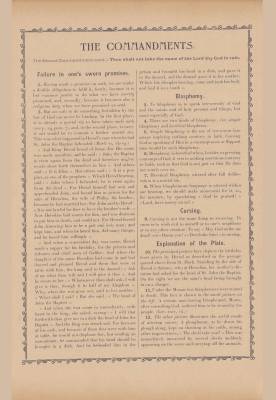
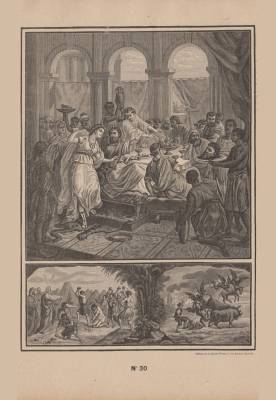
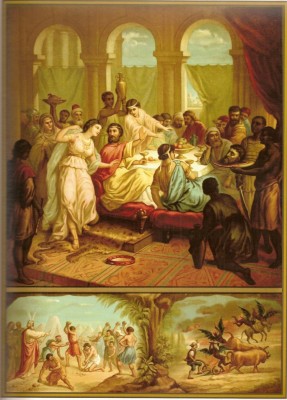
THE COMMANDMENTS.
The Second Commandment (contd.):
Thou shalt not take the name of the Lord thy God in vain.
Failure in one’s sworn promises.
1. Having made a promise on oath, we are under a double obligation to fulfil it, firstly, because it is but common justice to do what we have merely promised, and, secondly, because it becomes also a religious duty when we have promised something on oath.
2. But an oath to do something forbidden by the law of God can never be binding. In the first place, it is already a mortal sin to have taken such oath (see p.29, para.7), and, in the second place, to carry it out would be to commit a further mortal sin. This was what happened in Herod’s case when he had St. John the Baptist beheaded (Mark VI, 14-19.)
« And King Herod heard of Jesus (for His name was made manifest) and he said: « John the Baptist is risen again from the dead and therefore mighty works show forth themselves in him ». And others said: « It is Elias ». But others said: « It is a prophet, as one of the prophets ». Which Herod hearing, said: « John whom I beheaded, he is risen again from the dead. ». For Herod himself had sent and apprehended John, and bound him in prison for the sake of Herodias, the wife of Philip, his brother, because he had married her. For John said to Herod: « It is not lawful for thee to have thy brother’s wife. » Now Herodias laid snares for him, and was desirous to put him to death, and could not. For Herod feared John, knowing him to be a just and holy man; and kept him, and when he heard him, did many things; and he heard him willingly ».
« And when a convenient day was come, Herod made a supper for his birthday, for the princes, and tribunes and chief men of Galilee. And when the daughter of the same Herodias had come in and had danced
and pleased Herod and them that were at table with him, the king said to the damsel: « Ask of me what thou wilt and I will give it thee ». And he swore to her: « Whatsoever thou shalt ask, I will give it thee, though it be the half of my kingdom ». Who, when she was gone out, said to her mother: « What shall I ask? » But she said: « The head of John the Baptist ».
« And when she was come in immediately, with haste to the king, she asked, saying: « I will that forthwith thou give me in a dish the head of John the Baptist ». And the king was struck sad. For because of his oath, and because of them that were with him at table, he would not displease her, but sending an executioner, he commanded that his head should be brought in a dish. And he beheaded him in the prison, and brought his head in a dish, and gave it to the damsel, and the damsel gave it to her mother. Which his disciples hearing, came and took his body, and laid it in a tomb ».
Blasphemy.
3. To blaspheme is to speak irreverently of God and the saints and holy persons and things, but more especially of God.
4. There are two kinds of blasphemy, viz; simple blasphemy and heretical blasphemy.
5. Simple blasphemy is the use of irreverent language implying nothing contrary to faith. Cursing God or speaking of Him contemptuous or flippant tone would be such blasphemy.
6. Blasphemy is heretical when, besides expressing contempt of God, it errs in making assertions contrary to faith, such as that God is not just or that He does not watch over us.
7. Heretical blasphemy uttered after full deliberation is a mortal sin.
8. When blasphemous language is uttered within our hearing, we should make atonement for it, as, for instance, by ejaculating « God be praised! » «Lord, have mercy on us! »
Cursing.
9. Cursing is not the same thing as swearing. To curse is to wish evil to oneself or to say « May God strike me dead! » or « Devil take him! » is cursing.
Explanation of the Plate.
10. The principal picture here depicts the birthday feast given by Herod as described in the passage quoted above from St. Mark. Standing by the side of Herod is Salome, who at Herodias, her mother’s dictation had asked for the head of St. John the Baptist. On the right we see the saint’s head being brought in on a charger.
11. Under the Mosaic law blasphemers were stoned to death. This fact is shown in the small picture on the left. A certain man having blasphemed, Moses, after consulting God, ordered him to be stoned by the people. (Lev. XXIV, 14)
12. The other picture illustrates the result of uttering curses. A ploughman, as he drove his plough along, kept on shouting at his cattle, among other imprecations, « The devil take you? » This was immediately answered by several devils suddenly appearing on the scene and carrying off the animals.
Catechism in Pictures – Text & picture 31
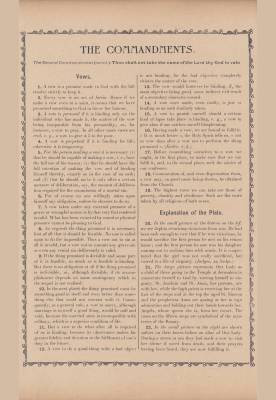

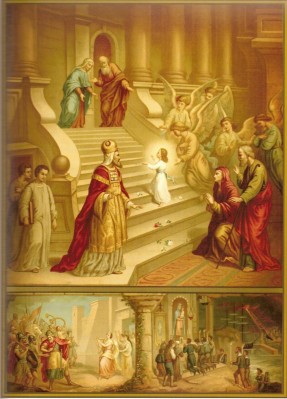
THE COMMANDMENTS.
The Second Commandment (concl.):
Thou shalt not take the name of the Lord thy God in vain.
Vows.
1. A vow is a promise made to God with the full resolve strictly to keep it.
2. Every vow is an act of latria. Hence if we make a vow even to a saint, it means that we have promised something to God in his or her honour.
3. A vow is personal if it is binding only on the individual who makes it, the matter of the vow being inseparable from his personality, as, for instance, a vow to pray. In all other cases vows are real, e. g., a vow to give £ 5 to the poor.
4. A vow is perpetual if it is binding for life; otherwise it is temporary.
5. For the person making a vow it is necessary (1) that he should be capable of making a vow, i. e., have the full use of his reason; (2) that he should have the full intention of making the vow and of binding himself thereby, exactly as in the case of an oath; and (3) that he should make it only after a certain measure of deliberation, say, the amount of deliberation required for the commission of a mortal sin.
6. For of course no one willingly takes upon himself an obligation, unless he chooses to do so.
7. A vow taken under any external pressure of a grave or wrongful nature is by that very fact rendered invalid. What has been extorted by moral or physical pressure cannot be pleasing to God.
8. As regards the thing promised it is necessary first of all that it should be feasible. No one is called upon to do the impossible. Thus, a vow not to sin at all is invalid, but a vow not to commit any grave sin or even any venial sin deliberately is valid.
9. If the thing promised is divisible and some part of it is feasible, so much as is feasible is binding. But there is no obligation at all if the thing promised is indivisible, or, although divisible, if its accomplishment depends on some contingency which in the sequel is not realised.
10. In the next place, the thing promised must be something good in itself and even better than something else that could not co-exist with it. Consequently, as a general rule, a vow to marry, although marriage is in itself a good thing, would be null and void, because the married state in incompatible with celibacy, which is a superior condition of life.
11. But a vow to do what after all is required of us is binding, because its observance makes for greater fidelity and devotion in the fulfilment of one’s duty in the future.
12. A vow to do a good thing with a bad object is not binding, for the bad objective completely vitiates the matter of the vow.
13. The vow would however be binding, if, the main objective being good, some indirect evil result of a secondary character ensued.
14. A vow once made, even rashly, is just as binding as an oath similarly taken.
15. A vow to punish oneself should a certain kind of lapse take place is binding, e.g., a vow to give alms if one catches oneself blaspheming.
16. Having made a vow, we are bound to fulfil it. « It is much better », the Holy Spirit tells us, « not to vow than after a vow not to perform the thing promised ». (Eccles. V, 4.)
17. Before committing ourselves to a vow we ought, in the first place, to make sure that we can fulfil it, and, in the second place, seek the advice of our confessor.
18. Commutation of, and even dispensation from, a vow may, on good cause being shown, be obtained from the Church.
19. The highest vows we can take are those of poverty, chastity and obedience. Such are the vows taken by all religious of both sexes.
Explanation of the Plate.
20. In the small picture at the bottom on the left we see Jephta returning victorious from war. He had been rash enough to vow that if he was victorious, he would sacrifice the first person he met on his return home; and the first person he saw was his daughter coming out to acclaim him with music. It is conjectured that the girl was not really sacrificed, but vowed to a life of virginity. (Judges XI, 30-40)
21. The large picture represents Our Lady as a child of three going to the Temple at Jerusalem to consecrate herself to God by vowing herself to virginity. St. Joachim and St. Anna, her parents, are with her, while the high priest is receiving her at the foot of the steps and at the top the aged St. Simeon and the prophetess Anna are gazing at her in rapt administration and holding out their hands towards her. Angels, whose queen she is, from her escort. The roses on the fifteen steps are symbolical of the mysteries of the Rosary.
22. In the small picture on the right are shown sailors on their knees before an altar of Our Lady. During a storm at sea they had made a vow to visit her shrine if saved from death, and their prayers having been heard, they are now fulfilling it.
Catechism in Pictures – Text & picture 32
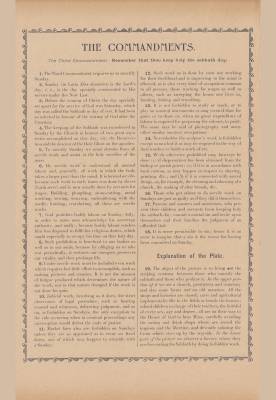

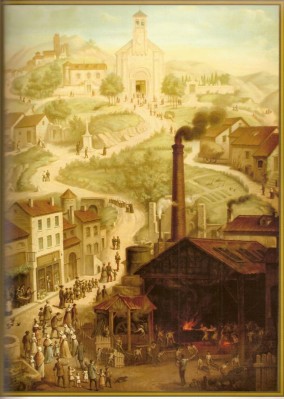
THE COMMANDMENTS.
The Third Commandment:
Remember that thou keep holy the sabbath day.
1. The Third Commandment requires us to sanctify Sunday.
2. Sunday (in Latin Dies Dominica) is the Lord’s day, i. e., is the day specially consecrated to His service under the New Law.
3. Before the coming of Christ the day specially set apart for the service of God was Saturday, which day was called the Sabbath or day of rest. It had been so selected in honour of the resting of God after the Creation.
4. The keeping of the Sabbath was transferred to Sunday by the Church in honour of two great mysteries accomplished on that day, the Resurrection and the descent of the Holy Ghost on the apostles.
5. To sanctify Sunday, we must abstain from all servile work and assist at the holy sacrifice of the Mass.
6. By servile work is understood all manual labour and, generally, all work in which the body takes a larger part than the mind. It is termed servile, because such work in early times was done by slaves (Latin servi) and is now usually done by servants for wages. Building, ploughing, stone-cutting, metal working, sewing, weaving, embroidering with the needle, knitting, crocheting, all these are servile works.
7. God prohibits bodily labour on Sunday, 1stly. in order to make man acknowledge his sovereign authority, and 2ndly., because bodily labour renders him less disposed to fulfil his religious duties, which ought especially to occupy his time on the holy day.
8. Such prohibition is beneficial to our bodies as well as to our souls, because by obliging us to take rest periodically, it restores our energies, preserves our vitality and thus prolongs life.
9. Under servile work must be included even work which requires but little effort to accomplish, such as making pictures and rosaries. It is not the amount of fatigue produced which determines the nature of the work, nor is that nature changed if the work is not done for gain.
10. Judicial work, involving as it does, the strict observance of legal procedure, such as hearing counsel and witnesses, delivering judgment, and so on, is forbidden on Sundays, the only exception to the rule occurring when in criminal proceeding any interruption would defeat the ends of justice.
11. Market fairs also are forbidden on Sunday unless they are so appointed as to recur on fixed dates, one of which may happen to coincide with a Sunday.
12. Such work as is done by men not working for their livelihood and is improving to the mind is allowed, as is also every kind of occupation common to all persons, those working for wages as well as others, such as sweeping the house one lives in, hunting, fishing and travelling.
13. It is not forbidden to study or teach, or to play musical instruments or sing (even if done for gain) or to draw or, when no great expenditure of labour is required for preparing the colours, to paint. The same may be said of photography and many other similar amateur occupations.
14. Nevertheless the sculptor’s work is forbidden except so much of it as may be required in the way of final touches to finish a work of art.
15. Work otherwise prohibited may however be done (1) if dispensation has been obtained from the bishop or parish priest; (2) if it is in accordance with local custom, as may happen in respect to shaving, printing, &c.; and (3) if it is connected with sacred things, as, for example, the cleaning and adorning of a church, the making of altar breads, &c.
16. Those who get others to do servile work on Sundays are just as guilty as if they did it themselves.
17. Parents and masters and mistresses, who prevent their children and servants from keeping holy the sabbath day, commit a mortal sin and invite upon themselves and their families the judgment of an offended God.
18. It is never permissible to sin; hence it is an error to imagine that a sin is the worse for having been committed on Sunday.
Explanation of the Plate.
19. The object of the picture is to bring out the striking contrast between those who sanctify the sabbath and those who profane it. In the upper portion of it we see a church, presbytery and cemetery and also some farms and an old mansion. All the shops and factories are closed; carts and agricultural implements lie idle in the fields or beside the houses; school children in charge of their teachers, the faithful of every sex, age and degree, all are on their way to the House of God to hear Mass, carefully avoiding the eating and drink shops where are seated the impious and the libertine, and devoutly saluting the Cross which rises up by the wayside. In the lower part of the picture we observe a factory where they are desecrating the Sabbath by doing forbidden work.



















































